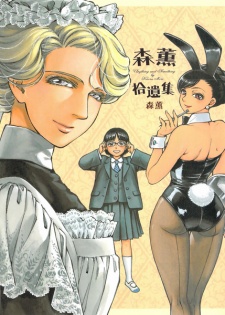Feb 3, 2022
Fourth Mori Kaoru review, and the closing for the month! This one concerns an anthology; around 60% of this book includes short-middle manga stories and the rest includes mainly columns and single page illustrations.
Anthologies are rarely if ever my cup of tea, hardly finding myself too satisfied reading short stories, but in this one's case I enjoyed what Mori herself described as sort of a mystery stew and a platter of appetizers. Let’s elaborate.
~~~ [1. Side dishes for your drink...] ~~~
Stories-wise this anthology is unusual for Mori, as she frequently toys with or totally deviates from her trademark 19-20th century historical fiction.
For one,
...
three stories are set during the Victorian-Edwardian eras yet two are comedies, one of which is also a parody of the relationship between servant-master. On stories that totally deviate, this book includes three modern school slice-of-life stories, one of which is wholesome, another a comedy and another a drama set in an art school. There are also two sexy adult-oriented stories, one which features a head waitress in a bunny suit deflecting advances and one which is a hot play on the Japanese idiom “swim practice on tatami mats”.
Case in point, Mori Kaoru did not pen every story she included, for Sumire’s Flowers, the dramatic school slice-of-life story, is penned by Fukushima Satoshi yet illustrated by her.
~~~ [2. Surprise, those are luxury appetizers...] ~~~
Despite being renown on her ultra-detailed work on Emma and on Otoyomegatari, this anthology displays a side of Mori Kaoru I had only slightly referenced in my Otoyomegatari review: that there is nothing she cannot depict. This extends even outside her trademarks.
Be it a woman in a bunny suit in all her erotic glory, her iconic England-themed artworks to the more mundane such a middle schooler wearing glasses or the interior of homes and libraries, this woman can prove herself capable of creating an eyeful of everything. It should be apparent there is fanservice here and then, but case in point a story also includes mild nudity. Encapsulation is great in all stories, with frequent usage of blank space to make for contrasts with key details and smooth paneling.
Notable, in comparison to her other works, is that one comedy story in this anthology is drawn in a remarkably different artstyle. This was Mori's original arstyle pre-Emma, one which she cites as having been influenced by the works of a horror mangaka named Yousuke Takagashi.
~~~ [3. Wait for the dessert...] ~~~
Once they complete the stories and read the related notes, the reader is treated by Mori to series of illustrations, most (but not all) of them on Mori's trademark works (Emma, Otoyomegatari, Shirley), commentary on Emma's anime, illustrations and notes to thank visitors to her manga's signings, as well as some of her research's fruits, namely facts on Victorian-era life and references on the role of servants in Agatha Christie’s works.
You could skip all those if you are interested only in the stories, but I recommend you give a chance to this part as well, even just to appreciate some gorgeous illustrations here and then, and to learn a thing or two on Victorian England. And if you are interested into Mori Kaoru as a creator and a person in general, it will hardly hurt at all to read patiently through everything.
Case in point, the book is hard to find in a stream, at least translated in English. It is highly affordable though (almost 10 dollars), and if you are interested in digital books you may immediately dig into it.
Either way, just like appetizers this book can be treated as an initiation to the main course of Mori’s lifework, or as a standalone taste sample of her peerless skill.
~~~ Hope you enjoyed my review! ~~~
Reviewer’s Rating: 7
What did you think of this review?
Nice
 0
0
Love it
 0
0
Funny
 0
0
Confusing
 0
0
Well-written
 0
0
Creative
 0
0Show all





















